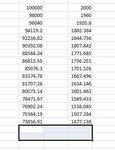Figure it out with your intelligence , a 50 % hit rate system with an equal target and stop loss , can have a variable position sizing system where distribution of profits and losses is unknown , can actually provide more consistent profits and be highly profitable .
This is why I don't follow the BSD boolox and links , as I said don't follow Gurus ....use your own intelligence , and I know you have plenty .......without me handing it on a plate
No I know exactly what you mean.
I just don't subscribe to that school of thought.
That is placing greater weighting and importance on certain trades over others.
Whilst that may be a valid discretionary approach, I automate, so the best
approach is to treat all trades as equal, for me at least.
As for risk per trade, mine is based on hard max stop, which is rarely hit.
So in that sense, my risk does alter, but I don't know that in advance,
or rather the algo doesn't, so it is safer to base it on max loss,
even though average loss per trade is about 60% ish of max risk.
Increasing risk based on average loss increases drawdown, which is about
the only stat I truly care about.

